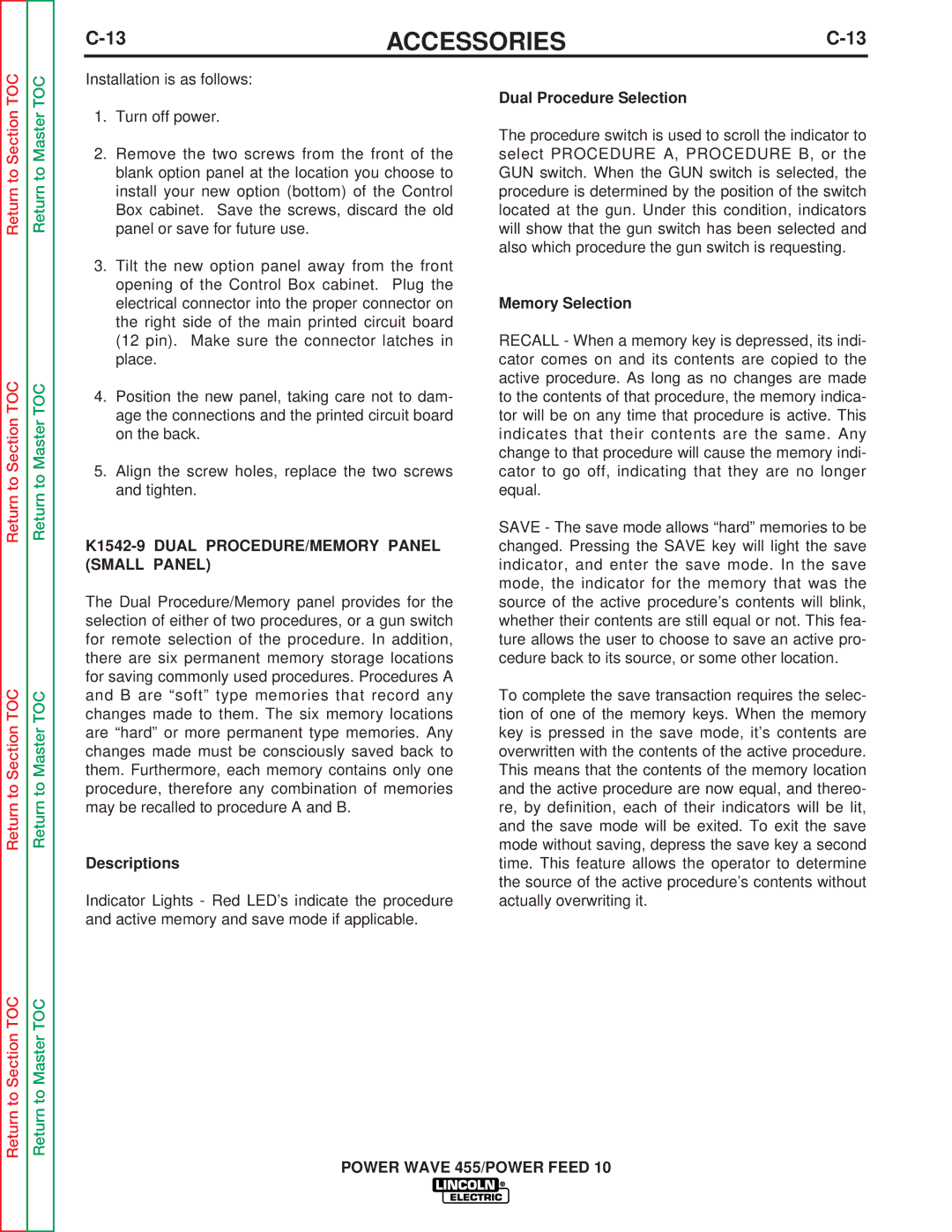
ACCESSORIES |
Return to Master TOC
Return to Master TOC
Return to Master TOC
Return to Master TOC
Installation is as follows:
1.Turn off power.
2.Remove the two screws from the front of the blank option panel at the location you choose to install your new option (bottom) of the Control Box cabinet. Save the screws, discard the old panel or save for future use.
3.Tilt the new option panel away from the front opening of the Control Box cabinet. Plug the electrical connector into the proper connector on the right side of the main printed circuit board (12 pin). Make sure the connector latches in place.
4.Position the new panel, taking care not to dam- age the connections and the printed circuit board on the back.
5.Align the screw holes, replace the two screws and tighten.
K1542-9 DUAL PROCEDURE/MEMORY PANEL (SMALL PANEL)
The Dual Procedure/Memory panel provides for the selection of either of two procedures, or a gun switch for remote selection of the procedure. In addition, there are six permanent memory storage locations for saving commonly used procedures. Procedures A and B are “soft” type memories that record any changes made to them. The six memory locations are “hard” or more permanent type memories. Any changes made must be consciously saved back to them. Furthermore, each memory contains only one procedure, therefore any combination of memories may be recalled to procedure A and B.
Descriptions
Indicator Lights - Red LED’s indicate the procedure and active memory and save mode if applicable.
Dual Procedure Selection
The procedure switch is used to scroll the indicator to select PROCEDURE A, PROCEDURE B, or the GUN switch. When the GUN switch is selected, the procedure is determined by the position of the switch located at the gun. Under this condition, indicators will show that the gun switch has been selected and also which procedure the gun switch is requesting.
Memory Selection
RECALL - When a memory key is depressed, its indi- cator comes on and its contents are copied to the active procedure. As long as no changes are made to the contents of that procedure, the memory indica- tor will be on any time that procedure is active. This indicates that their contents are the same. Any change to that procedure will cause the memory indi- cator to go off, indicating that they are no longer equal.
SAVE - The save mode allows “hard” memories to be changed. Pressing the SAVE key will light the save indicator, and enter the save mode. In the save mode, the indicator for the memory that was the source of the active procedure’s contents will blink, whether their contents are still equal or not. This fea- ture allows the user to choose to save an active pro- cedure back to its source, or some other location.
To complete the save transaction requires the selec- tion of one of the memory keys. When the memory key is pressed in the save mode, it’s contents are overwritten with the contents of the active procedure. This means that the contents of the memory location and the active procedure are now equal, and thereo- re, by definition, each of their indicators will be lit, and the save mode will be exited. To exit the save mode without saving, depress the save key a second time. This feature allows the operator to determine the source of the active procedure’s contents without actually overwriting it.
POWER WAVE 455/POWER FEED 10
